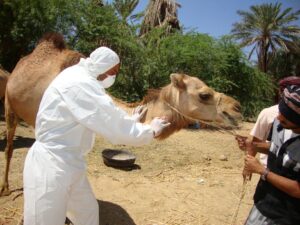The Hazardous Materials Regulations (HMR) of the Pipeline and Hazardous Materials Safety Administration within the U.S. Department of Transportation (USDOT/PHMSA) classify and regulate the transportation of hazardous materials. Included in the twenty hazard classes and divisions identified in the HMR at 49 CFR 173.134 is Division 6.2 Infections Substance; Divisions 6.2 is further broken down into Category A and Category B.
The purpose of this article is to identify and explain (and provide examples of) a Category A Division 6.2 Infectious Substance.
A Division 6.2 Infectious Substance is a material known or reasonably expected to contain a pathogen.
A pathogen is a microorganism or other agent that can cause disease in humans or animals. Examples include:
- Bacteria
- Viruses
- Rickettsiae
- Parasites
- Fungi
- Proteinaceous infectious particle (prion)
There are two types of a Division 6.2 Infectious Substance:
- Category A
- Category B
|
Note: Category A poses a higher health risk than Category B. |
A Category A infectious substance is one in a form capable of causing permanent disability or life-threatening or fatal disease in otherwise healthy humans or animals when exposure to it occurs.
An exposure occurs when an infectious substance is released outside of its protective packaging, resulting in physical contact with humans or animals.
From USDOT/PHMSA guidance:
Classification must be based on the known medical history or symptoms of the source patient or animal, endemic local conditions, or professional judgment concerning the individual circumstances of the source human or animal.
A Category A Infectious Substance must be assigned to identification number UN2814 (affecting humans) or UN2900 (affecting animals), as appropriate.
|
Like this article? Subscribe to my Monthly Newsletter No marketing emails! |
EXAMPLES OF CATEGORY A: UN2814, INFECTIOUS SUBSTANCES AFFECTING HUMANS
MICRO-ORGANISM
- Bacillus anthracis (cultures only)
- Brucella abortus (cultures only)
- Brucella melitensis (cultures only)
- Brucella suis (cultures only)
- Burkholderia mallei—Pseudomonas mallei—Glanders (cultures only)
- Burkholderia pseudomallei—Pseudomonas pseudomallei (cultures only)
- Chlamydia psittaci—avian strains (cultures only)
- Clostridium botulinum (cultures only)
- Coccidioides immitis (cultures only)
- Coxiella burnetti (cultures only)
- Crimean-Congo hemorrhagic fever virus
- Dengue virus (cultures only)
- Eastern equine encephalitis virus (cultures only)
- Escherichia coli, verotoxigenic (cultures only)
- Ebola virus
- Flexal virus
- Francisella tularensis (cultures only)
- Guanarito virus
- Hantaan virus
- Hantaviruses causing hemorrhagic fever with renal syndrome
- Hendra virus
- Herpes B virus (cultures only)
- Human immunodeficiency virus (cultures only)
- Highly pathogenic avian influenza virus (cultures only)
- Japanese Encephalitis virus (cultures only)
- Junin virus
- Kyasanur forest disease virus
- Lassa virus
- Machupo virus
- Marburg virus
- Monkeypox virus
- Mycobacterium tuberculosis (cultures only)
- Nipah virus
- Omsk hemorrhagic fever virus
- Poliovirus (cultures only)
- Rabies and other lyssaviruses (cultures only)
- Rickettsia prowazekii (cultures only)
- Rickettsia rickettsia (cultures only)
- Rift Valley fever virus (cultures only)
- Russian spring-summer encephalitis virus (cultures only)
- Sabia virus
- Shigella dysenteriae type I (cultures only)
- Tick-borne encephalitis virus (cultures only)
- Variola virus
- Venezuelan equine encephalitis virus (cultures only)
- Vesicular stomatitis virus (cultures only)
- West Nile virus (cultures only)
- Yellow fever virus (cultures only)
- Yersinia pestis (cultures only)
|
Daniels Training Services, Inc. 815.821.1550 |
EXAMPLES OF CATEGORY A: UN2900, INFECTIOUS SUBSTANCES AFFECTING ANIMALS
MICRO-ORGANISM
- African swine fever virus (cultures only)
- Avian paramyxovirus Type 1—Velogenic Newcastle disease virus (cultures only)
- Classical swine fever virus (cultures only)
- Foot and mouth disease virus (cultures only)
- Lumpy skin disease virus (cultures only)
- Mycoplasma mycoides—Contagious bovine pleuropneumonia (cultures only)
- Peste des petits ruminants virus (cultures only)
- Rinderpest virus (cultures only)
- Sheep-pox virus (cultures only)
- Goatpox virus (cultures only)
- Swine vesicular disease virus (cultures only)
Conclusion:
While there are exceptions from full regulation for certain Category B Infectious Substances at §173.134(b), it is unlikely there will be any exception from full regulation for a Category A Infectious Substance. Authorized packaging and the packing instructions for a Category A Infectious Substance are found at §173.196 and will include the following:
- Packaging must meet test standards of §178.609.
- Must be in a triple packaging consisting of:
- Primary leakproof receptacle.
- Leakproof secondary packaging.
- Absorbent and cushioning materials if hazardous material is a liquid.
- Rigid outer packaging.
- Display the UN Standard mark on the outer packaging per §178.503(f).
- Display the Division 6.2 Infectious Substance HazMat label.
- Display other package marks as required by the HMR.
And, of course, all personnel with a direct effect on the safe transportation of this HazMat (i.e., pack, label, mark, load or unload vehicle, operate motor vehicle, prepare / review / sign the shipping paper, or directly supervise any person performing any of the preceding must receive initial and recurrent HazMat Employee Training.


